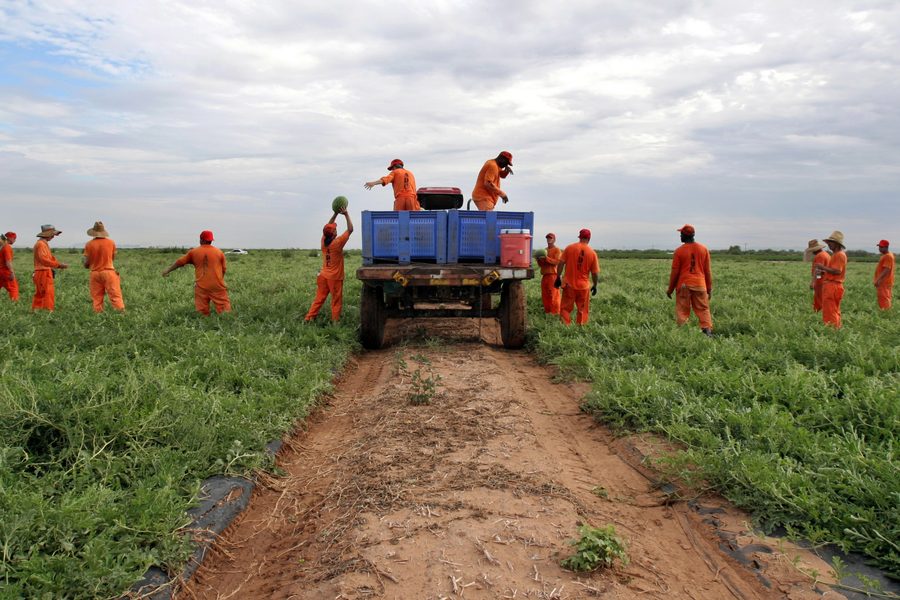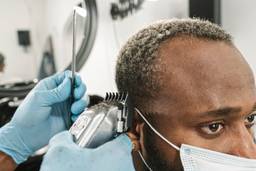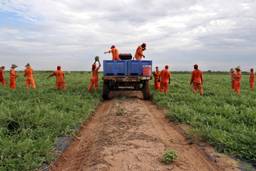
ABILENE, TEXAS — Temperatures reached 97 degrees on June 21 at the French Robinson Unit prison the day Seth Donnelly collapsed. The Texas Observer reported Seth passed out during his prison job of training attack dogs — running around in a 75-pound “fight suit” while the dogs tried to bite him. Seth’s internal body temperature was 106 when he reached the hospital, where doctors eventually took him off life support. He died on June 23, and his preliminary autopsy lists multiorgan failure following severe hyperthermia.
These conditions aren’t new. Danielle, who asked for In These Times to withhold her last name to protect her family-run business from social stigma, says she woke up in her cell in Texas at Gatesville Prison one typical early morning in July 2015, drenched in sweat. Without time (or permission) to shower or brush her teeth, she reports she was corralled to the fields in a heavy uniform.
“It didn’t feel safe,” says Danielle, who explains she picked tomatoes and jalapeño peppers without pay. Gatesville’s average high temperature that month was 98 degrees. “Texas in July, it’s like sitting on hell’s doorstep,” she says.
A guard who Danielle says she was “deathly terrified of” patrolled the “state property” (the term guards used for incarcerated people) on a horse. Danielle says she was not provided gloves, which often left her hands exposed to thorns and caustic jalapeño juices. One day, Danielle says, after several hours, another woman without gloves asked the guard if they could wash out their wounds. According to Danielle, the guard stopped, pulled her gun and yelled like a drill sergeant: “What are the rules of the field?” Danielle testifies that another group yelled back, “No breaks until work is done.”
Although there is little data or reporting on heat conditions for incarcerated workers, they may be especially vulnerable to being pushed to their limits because there are few labor protections and little to no oversight.
The Occupational Safety and Health Act of 1970 requires employers to protect workers from serious hazards (including heat-related risks). Though the Act does not cover incarcerated laborers, the Occupational Safety and Health Administration (OSHA) has said federal prisons must still uphold its standards — which include, when the heat index hits 91‑103 degrees, reminding workers to drink 4 cups of water an hour, scheduling frequent breaks in cool areas, and developing work/rest schedules for workers in heavy clothing.
But OSHA rules do not apply to state prisons. Twenty-two states have adopted OSHA “state plans,” which cover state prisons with standards intended to be at least as effective as federal standards. Eight of the 10 states with the highest incarceration rates have declined to adopt these plans.
“The guards could literally do whatever they wanted to us,” says Danielle, who was incarcerated in Texas from August 2014 to September 2015..
Danielle’s stated working conditions appear antithetical to OSHA’s guidelines. “There was a vehicle that would come by and bring some water, but if the vehicle broke down you were out of luck for water that day,” she says. “That happened numerous times. Even when we get water it was gone within a few minutes and they won’t refill it for you. There are 50-plus women and the women in the back don’t get any.”
Danielle also says adequate work/rest schedules were not implemented. “We would go on for four hours or more before we sat in the shade,” she says. “I remember thinking — I know there were women there who were much older than me doing the exact same thing — ‘What would my mother do?’ She would die. She would just fall over on the field and die. How is this possibly allowed?”
Danielle was not alone: Nearly half of people imprisoned in the U.S. work while incarcerated, a population disproportionately likely to be Black. Penal labor became a more significant part of the American economy following the Civil War; police would conduct sweeps and make arrests of Black men when plantations needed additional labor for planting, cutting and harvesting crops. Today, a majority of incarcerated workers perform “institutional maintenance,” which includes tasks like mowing the compound lawn and mopping floors. A relatively small number of others work in “correctional industries,” manufacturing things like license plates, sewing American flags and — as in Danielle’s case — harvesting vegetables that are later sold for a profit. All seven states that don’t pay for non-industry labor are in the South, which can reach dangerously hot summer temperatures.
Even indoor prison work can be dangerous, as 13 states — most of them in the South — do not equip prisons with air conditioning. As Time noted in 2016, more than 120,000 beds in Texas’ criminal justice system do not have air conditioning, while “less than 1% of free Texans live in a home without air conditioning.” OSHA recommends indoor temperatures between 68‑76 degrees, and Texas county jails must be between 65‑85 degrees — but not Texas state prisons.
While there have not been any assessments of the occupational health of incarcerated workers, it is well documented that heat-related illnesses are a general problem for people in prisons, even when they are not working.
Anecdotal evidence of heat-related problems inside prisons provides additional insight. In a first-person account for The Marshall Project, Timothy Bazrowx described being beaten with a pipe and how a field captain shot at his feet during his first day of work in the fields. In 2017, The Daily Haze published a video of incarcerated workers screaming for help inside of a St. Louis workhouse as temperatures broke 100 degrees. The Campaign to Fight Toxic Prisons, a group of grassroots advocates, said it is “common for prisoners within [the Florida Department of Corrections] to be routinely denied adequate food and safe drinking water, especially those who go outside the gate on work crews. They are never given enough to eat and are forced to work in all conditions despite injury, sickness, brutal temperatures.”
Andrew, a 31-year-old who has been incarcerated in Florida since he was 17, says confined laborers are routinely dehydrated on the job. Andrew says his first mandatory prison job, in 2006 at age 18 in Hamilton Correctional Institution (HCI), consisted of mowing the swampy compound lawn using a dull-bladed non-electric push mower in cloth shoes with poor soles from 8 a.m. until the end of the day and/or job completion alongside a group of other men. The closest large city to HCI, Valdosta, Georgia, had an average high of about 92 degrees during Andrew’s first summer on the job. The confined laborers were generally given water in the mornings, according to Andrew, but the igloo cooler was empty within an hour and a half. During his time on the job, he frequently witnessed people collapsing from fatigue, he told In These Times. And sometimes, he says, the simple act of taking a break resulted in violent discipline: “The officers will come and they’ll put you in handcuffs … and a lot of times the handcuffs turn into you getting slammed on the floor,” Andrew says.
Limited strides to cool prisons in Texas have been made through civil litigation. After four years of litigation, in May 2018, the Texas Department of Criminal Justice (TDCJ) agreed to install air conditioning in the housing sections of Wallace Pack Unit, which houses many elderly and vulnerable prisoners. As recently as August 9, however, Federal Judge Keith Ellison accused TDCJ of not fully complying with the settlement.
The suffering endured in the heat, which will worsen with climate change, is stoked by cruelty. “Despite the heat and terrible conditions we lived in — basically, sleeping in a sauna — it was so much more than that,” says Danielle. “It was like [the guards] got a thrill out of making us feel we were lesser than people.”






